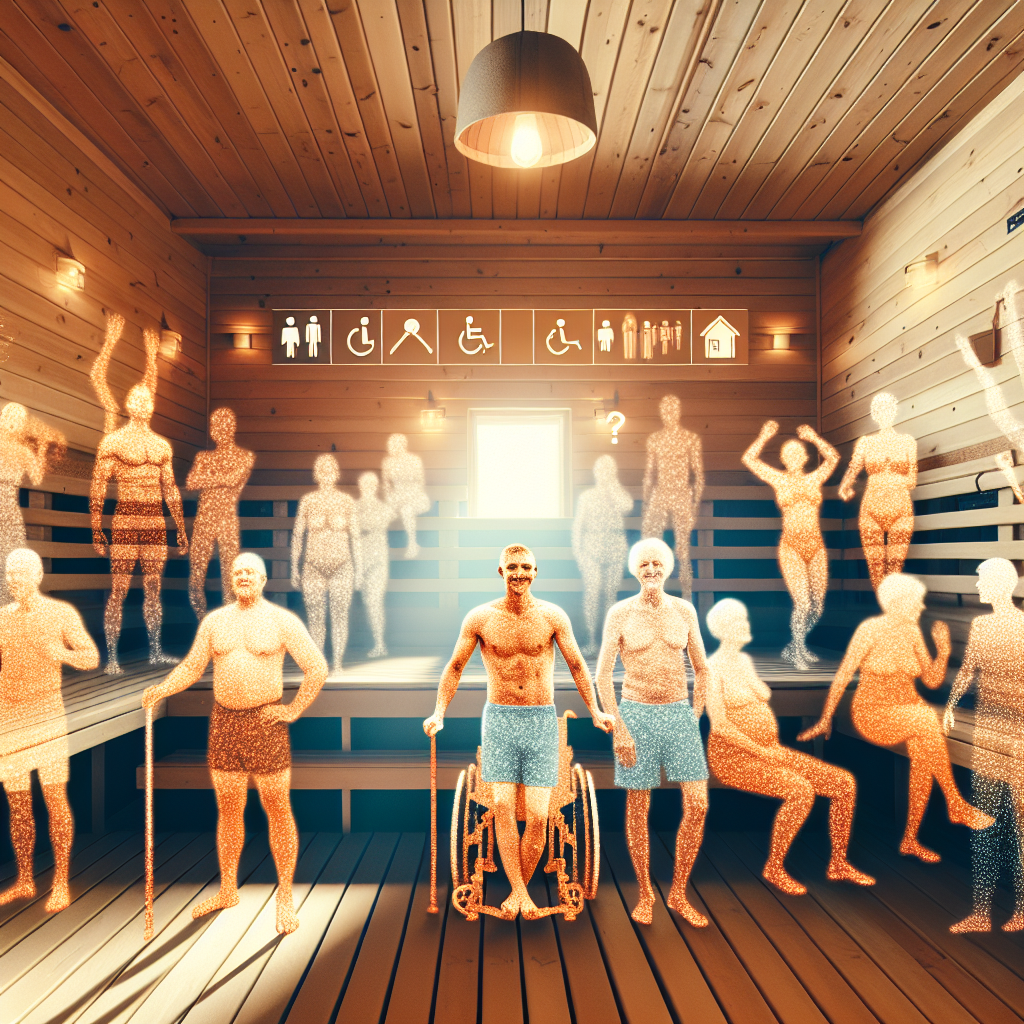Imagine stepping into a world of soothing warmth, where the stresses of everyday life melt away. Picture yourself enveloped by the calming heat of a traditional sauna, feeling your body rejuvenate as you relax and unwind. But wait, can anyone actually use a traditional sauna? The answer is a resounding yes – whether you’re a seasoned sauna enthusiast or a first-timer, this ancient therapeutic practice is open to all, offering a multitude of health benefits and a chance to recharge your body and mind. So, why wait? Step into the gentle embrace of a traditional sauna and experience the transformative power it holds for everyone.

Physical Considerations
Age Restrictions
When it comes to using a traditional sauna, age can be a factor to consider. While there isn’t a set age restriction, it is important to use caution when bringing young children into a sauna. Their bodies may not be able to handle the heat as well as adults, so it is recommended to consult with a medical professional before bringing children into a sauna.
Health Conditions
Individuals with certain health conditions should also be cautious when using a traditional sauna. Conditions such as high blood pressure, heart disease, or respiratory problems may be worsened by the heat and steam in a sauna. It’s important to consult with a healthcare provider to determine if using a sauna is safe for your specific condition.
Pregnancy
Pregnant women should also exercise caution when using a traditional sauna. The high heat can potentially be harmful to the developing fetus, so it is generally recommended to avoid using a sauna during pregnancy. It’s always best to consult with a healthcare provider for personalized advice and guidance.
Physical Fitness
Generally, individuals in good physical health and fitness can safely use a traditional sauna. However, it’s important to listen to your body and not overexert yourself. If you have any concerns about your physical readiness for a sauna session, it’s always best to check with a healthcare professional before taking part.
Mental and Emotional Considerations
Mental Health
Using a traditional sauna can have positive effects on mental health. The relaxation and calming environment of a sauna can help relieve stress and anxiety. However, individuals with certain mental health conditions should approach sauna use with caution. Conditions such as claustrophobia or anxiety disorders may be triggered by the enclosed space of a sauna. It’s important to be aware of your own mental health and seek professional advice if you have any concerns.
Emotional Stability
If you struggle with emotional stability or have a history of mood disorders, it’s crucial to consider how the intense heat and sensory experience of a traditional sauna may affect you. While some individuals find it beneficial in improving their mood and overall well-being, it’s essential to approach sauna use with self-awareness and take breaks if needed.
Anxiety and Stress
Saunas are often used as a means of relaxation and stress relief. The heat and steam can help soothe both the body and the mind. It’s important to note, however, that for some individuals, the heat and high temperatures of a traditional sauna may actually exacerbate their anxiety or stress levels. It’s best to know your own reactions to heat and stress and proceed accordingly.
Sensory Sensitivities
Individuals with sensory sensitivities, such as those with autism spectrum disorders or other sensory processing disorders, may find a traditional sauna overwhelming. The heat, humidity, and enclosed space can be too intense for some individuals. It’s important to consider your own sensory sensitivities before using a sauna and seek alternative options if necessary.
Safety Precautions
Time Limits
When using a traditional sauna, it’s important to adhere to recommended time limits. Spending too much time in a sauna can lead to dehydration or overheating. Generally, it is recommended to limit sauna sessions to 10-15 minutes at a time, with breaks in between to cool down and hydrate.
Hydration
Staying hydrated is crucial when using a traditional sauna. The intense heat and sweat can lead to fluid loss, so it’s important to drink water before, during, and after a sauna session. It’s best to bring a water bottle into the sauna with you and take small sips throughout your session.
Skin Sensitivity
Some individuals may have skin sensitivities that can be exacerbated by the heat and high temperatures of a traditional sauna. It’s important to monitor your skin for any signs of discomfort or irritation while using a sauna. If you have sensitive skin, it may be beneficial to speak with a dermatologist before using a sauna.
Clothing
When using a traditional sauna, it’s customary to be in the nude or wear minimal clothing. The heat and steam work best when they can directly contact your skin. However, it’s important to respect individual comfort levels and cultural norms. If you prefer to wear a bathing suit or towel, that is perfectly acceptable.
Potential Benefits
Relaxation and Stress Relief
One of the key benefits of using a traditional sauna is relaxation and stress relief. The combination of heat, steam, and the calming environment of a sauna can help reduce tension and promote a sense of relaxation. Sauna sessions can be a great way to unwind and de-stress after a long day.
Improved Circulation
The heat in a sauna causes your blood vessels to dilate, which can help improve circulation. This increased blood flow can bring additional nutrients and oxygen to your muscles and organs, which can have a positive impact on your overall health and well-being.
Detoxification
Many sauna enthusiasts believe that saunas aid in the detoxification process by promoting sweating and releasing toxins from the body. While more research is needed to fully understand the extent of these benefits, the experience of sweating in a sauna can leave you feeling refreshed.
Muscle Recovery
Saunas can also be beneficial for muscle recovery after a workout or intense physical activity. The heat can help relax and soothe tired muscles, reducing inflammation and promoting faster recovery. Taking a sauna session after exercise can be a great way to aid in muscle relaxation and promote overall recovery.

Potential Risks
Dehydration
One of the main risks associated with using a traditional sauna is dehydration. The high temperatures and sweating can cause significant fluid loss from the body. It’s essential to stay hydrated and drink plenty of water before, during, and after your sauna session to avoid dehydration.
Heat Exhaustion
Prolonged exposure to the intense heat in a sauna can lead to heat exhaustion. Symptoms may include dizziness, weakness, rapid heartbeat, and nausea. It’s important to listen to your body and take breaks or leave the sauna if you start to feel lightheaded or unwell.
Skin Irritation
The heat and steam in a sauna can cause skin irritation or dryness in some individuals. It’s important to monitor your skin and discontinue sauna use if you experience any discomfort or irritation. Taking lukewarm showers and moisturizing after a sauna session can help alleviate any potential skin irritation.
Dizziness and Fainting
The combination of high temperatures and intense heat in a sauna may cause some individuals to feel dizzy or even faint. If you experience dizziness or lightheadedness, it’s crucial to leave the sauna and cool down immediately. It’s best to sit or lie down and drink water to help restore your balance.
Alternatives to Traditional Saunas
Steam Rooms
A common alternative to traditional saunas are steam rooms. Steam rooms use moist heat to create a steamy environment, which can provide similar benefits to a sauna. The lower temperatures and higher humidity levels in steam rooms may be more suitable for individuals who find traditional saunas too hot or drying.
Infrared Saunas
Infrared saunas use infrared heaters to emit radiant heat, which is absorbed directly by the body without significantly heating the surrounding air. This type of sauna can offer similar benefits to traditional saunas but at lower temperatures. Infrared saunas may be a good alternative for individuals who cannot tolerate the high heat of traditional saunas.
Portable Saunas
For individuals who don’t have access to a traditional sauna or prefer a more portable option, portable saunas are available on the market. These compact and foldable saunas can be set up in your home and provide a sauna-like experience. Portable saunas offer convenience and flexibility for those who want to enjoy the benefits of a sauna at their own convenience.
Cultural Variations
It’s important to note that sauna practices and preferences may vary across different cultures. In some cultures, saunas are enjoyed in communal settings, while in others, they are used for individual relaxation. It’s important to respect and adhere to local customs and guidelines when using a traditional sauna in different cultural contexts.
How to Use a Traditional Sauna
Preparation
Before entering a traditional sauna, it’s important to prepare your body. Take a shower to cleanse your skin and remove any oils or lotions that may interfere with sweating. It’s also essential to hydrate yourself by drinking water before your sauna session.
Entering the Sauna
When entering the sauna, it’s important to adjust to the heat gradually. Start by sitting on a towel or bench and allow your body to acclimate to the temperature. It’s best to enter the sauna for short periods initially, gradually increasing the duration as your body becomes accustomed to the heat.
Sauna Etiquette
Respecting sauna etiquette is important when using a traditional sauna. It’s customary to sit or lie on a towel to avoid sweating directly onto the benches. It’s also important to keep conversations quiet and respectful to maintain a calm and relaxing environment for everyone.
Cooling Down
After your sauna session, it’s crucial to cool down gradually. You can do this by stepping outside or taking a lukewarm shower. It’s important to allow your body temperature to regulate and drink water to rehydrate. After cooling down, it’s beneficial to rest and relax to fully enjoy the post-sauna benefits.
Conclusion
Overall, traditional saunas can offer a variety of benefits, such as relaxation, improved circulation, and muscle recovery. However, it’s important to consider physical and mental health conditions, as well as follow safety precautions, to ensure a safe and enjoyable sauna experience. Alternatives to traditional saunas, such as steam rooms or infrared saunas, provide options for individuals with specific preferences or sensitivities. By understanding how to use a traditional sauna properly and respecting sauna etiquette, you can maximize the benefits and minimize potential risks associated with sauna use. Remember to always consult with a healthcare professional if you have any concerns or underlying health conditions before incorporating sauna sessions into your routine.

